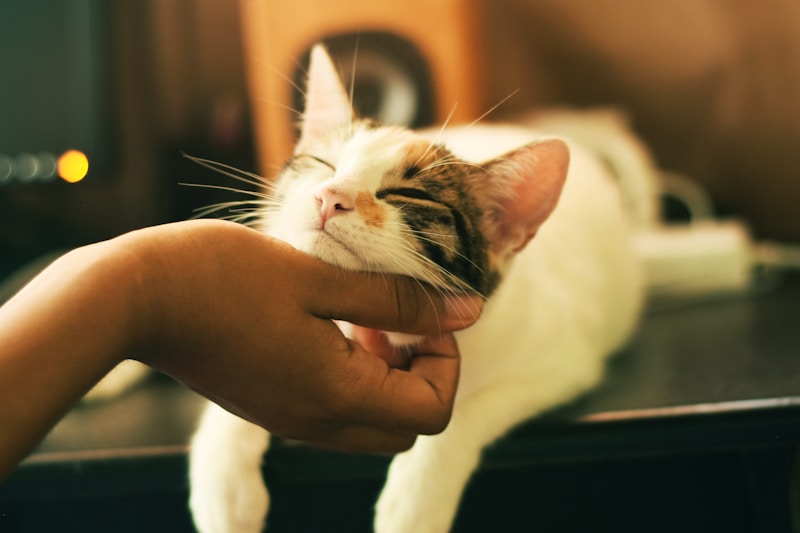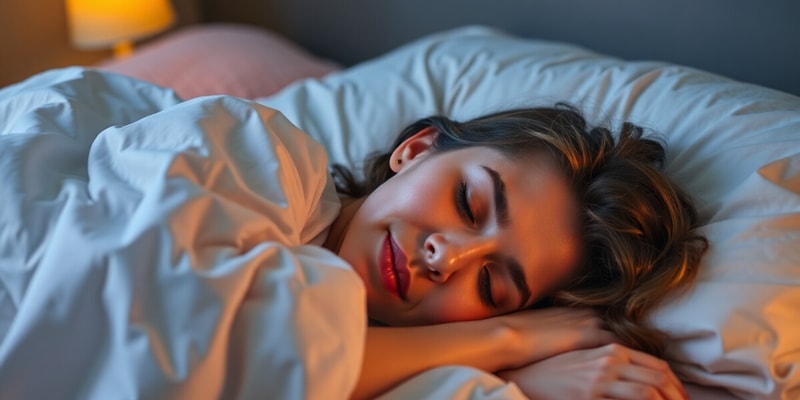Podcast
Questions and Answers
Which neurotransmitter is predominantly produced during REM sleep?
Which neurotransmitter is predominantly produced during REM sleep?
What is the primary function of the thalamus during wakefulness?
What is the primary function of the thalamus during wakefulness?
What characterizes the neurochemistry of active wakefulness?
What characterizes the neurochemistry of active wakefulness?
Which structure is referred to as the activating center of the brain?
Which structure is referred to as the activating center of the brain?
Signup and view all the answers
During which phase is the production of serotonin and noradrenaline minimized?
During which phase is the production of serotonin and noradrenaline minimized?
Signup and view all the answers
What happens to sensory processing when an individual is asleep?
What happens to sensory processing when an individual is asleep?
Signup and view all the answers
In which stage is slow wave activity primarily engaged?
In which stage is slow wave activity primarily engaged?
Signup and view all the answers
Which neurotransmitter is not produced during NREM sleep?
Which neurotransmitter is not produced during NREM sleep?
Signup and view all the answers
What primarily happens to the thalamus during NREM sleep?
What primarily happens to the thalamus during NREM sleep?
Signup and view all the answers
Which neurotransmitter is associated with increased brain power during REM sleep?
Which neurotransmitter is associated with increased brain power during REM sleep?
Signup and view all the answers
What is the state of the prefrontal cortex during REM sleep?
What is the state of the prefrontal cortex during REM sleep?
Signup and view all the answers
Which brain region is primarily involved in emotional regulation during REM sleep?
Which brain region is primarily involved in emotional regulation during REM sleep?
Signup and view all the answers
Which method is NOT typically used to measure brain activity during sleep?
Which method is NOT typically used to measure brain activity during sleep?
Signup and view all the answers
What type of sleep is characterized by high frequency, low amplitude brain waves similar to wakefulness?
What type of sleep is characterized by high frequency, low amplitude brain waves similar to wakefulness?
Signup and view all the answers
Which of the following processes primarily indicates sleep debt during wakefulness?
Which of the following processes primarily indicates sleep debt during wakefulness?
Signup and view all the answers
What is the primary function of zeitgebers in regulating circadian rhythms?
What is the primary function of zeitgebers in regulating circadian rhythms?
Signup and view all the answers
What term describes the phenomenon where an organism experiences increased REM sleep after a period of deprivation?
What term describes the phenomenon where an organism experiences increased REM sleep after a period of deprivation?
Signup and view all the answers
In which stage of sleep does the brain show sleep spindles and K-complexes, which are important for memory consolidation?
In which stage of sleep does the brain show sleep spindles and K-complexes, which are important for memory consolidation?
Signup and view all the answers
What physiological changes occur in the suprachiasmatic nucleus (SCN) in response to light exposure?
What physiological changes occur in the suprachiasmatic nucleus (SCN) in response to light exposure?
Signup and view all the answers
Which sleep stage involves the absence of eye movements and is characterized by synchronized, high amplitude brain waves?
Which sleep stage involves the absence of eye movements and is characterized by synchronized, high amplitude brain waves?
Signup and view all the answers
What is the relationship between circadian rhythms and sleep cycles?
What is the relationship between circadian rhythms and sleep cycles?
Signup and view all the answers
Which biological rhythm is associated with cycles that last longer than 24 hours?
Which biological rhythm is associated with cycles that last longer than 24 hours?
Signup and view all the answers
What behavioral characteristic is associated with Stage 1 NREM sleep?
What behavioral characteristic is associated with Stage 1 NREM sleep?
Signup and view all the answers
What is the average duration of one complete sleep cycle in humans?
What is the average duration of one complete sleep cycle in humans?
Signup and view all the answers
Which type of sleep is primarily characterized by low muscle tone and atonia?
Which type of sleep is primarily characterized by low muscle tone and atonia?
Signup and view all the answers
Which of the following correctly describes the effect of light on melatonin secretion?
Which of the following correctly describes the effect of light on melatonin secretion?
Signup and view all the answers
What represents the changes in the sleep architecture from childhood to old age?
What represents the changes in the sleep architecture from childhood to old age?
Signup and view all the answers
How does caffeine affect the sleep regulation processes?
How does caffeine affect the sleep regulation processes?
Signup and view all the answers
At what age does sleep transition to predominantly monophasic sleep?
At what age does sleep transition to predominantly monophasic sleep?
Signup and view all the answers
What is the main factor driving the feeling of sleepiness after extended wakefulness?
What is the main factor driving the feeling of sleepiness after extended wakefulness?
Signup and view all the answers
Which statement best describes Process S in the context of sleep-wake regulation?
Which statement best describes Process S in the context of sleep-wake regulation?
Signup and view all the answers
Which characteristic of REM sleep is noted in creative problem solving?
Which characteristic of REM sleep is noted in creative problem solving?
Signup and view all the answers
What can be expected from sleep patterns as individuals age from newborns to adults?
What can be expected from sleep patterns as individuals age from newborns to adults?
Signup and view all the answers
What happens to total sleep time from young adulthood to elderly years?
What happens to total sleep time from young adulthood to elderly years?
Signup and view all the answers
During sleep deprivation, when does Process C reach its lowest point?
During sleep deprivation, when does Process C reach its lowest point?
Signup and view all the answers
What effect does sleep have on the creative process according to historical examples?
What effect does sleep have on the creative process according to historical examples?
Signup and view all the answers
What was the main benefit observed for students who took a nap after the lecture?
What was the main benefit observed for students who took a nap after the lecture?
Signup and view all the answers
Which time points showed a significant difference in test scores between nap and non-nap groups?
Which time points showed a significant difference in test scores between nap and non-nap groups?
Signup and view all the answers
How did the performance of non-nap students change by the fifth day post lecture?
How did the performance of non-nap students change by the fifth day post lecture?
Signup and view all the answers
What was the estimated decrease in performance for non-nap students one day after the lecture?
What was the estimated decrease in performance for non-nap students one day after the lecture?
Signup and view all the answers
What aspect of the students' condition was not verified by the researchers during the napping study?
What aspect of the students' condition was not verified by the researchers during the napping study?
Signup and view all the answers
In which country did the study on napping and memory take place?
In which country did the study on napping and memory take place?
Signup and view all the answers
What type of lecture content was presented to the students during the study?
What type of lecture content was presented to the students during the study?
Signup and view all the answers
How long was the lecture given to the students before they were tested?
How long was the lecture given to the students before they were tested?
Signup and view all the answers
Study Notes
Sleep Basics
- Sleep measurement categorized into phenomenology, behavior, and physiology.
- Phenomenology includes loss of awareness, disconnection of thoughts, disorientation, and dreams.
- Behavioral measurements focus on body position, muscle tone, circadian rhythms, and responsiveness.
- Physiological measures provide the most reliable data on sleep, observing brain and body changes.
Polysomnography (PSG)
- PSG integrates three techniques: EEG (brain activity), EOG (eye movement), and EMG (muscle activity).
- EEG tracks electrical brain activity during sleep, producing brain wave patterns.
- EOG measures voltage changes as the eyes move, critical for detecting sleep stages.
- EMG assesses muscle tension, important for differentiating sleep stages.
Types of Sleep
- Non-Rapid Eye Movement (NREM) and Rapid Eye Movement (REM) sleep stages recognized.
- NREM includes multiple stages leading to deeper sleep (Stage 1, 2, Slow-Wave Sleep, Stage 3, and 4).
- REM involves PGO waves, increasing dream activity, with paralysis to protect the body during dreams.
- NREM and REM cycles last about 90 minutes, shifting towards more REM sleep as the night progresses.
Hypnogram
- Hypnograms illustrate sleep architecture, showing the transition between NREM and REM sleep.
- More slow-wave NREM occurs early, with REM sleep increasing towards morning.
Brain and Sleep Stages
- Awake state features high-frequency (15-30Hz), low-amplitude, desynchronized brain waves.
- Stage 2 NREM showcases sleep spindles and K-complexes, key for memory consolidation.
- Slow-wave sleep (Stage 3 and 4) consists of synchronous, high-amplitude brain waves with significant reduction in muscle tone.
- REM sleep characterized by low-amplitude, high-frequency brain waves similar to wakefulness, combined with muscle atonia.
Circadian Rhythms
- Circadian rhythms are biological cycles occurring approximately every 24 hours, regulating sleep/wake cycles and various bodily functions.
- Types of rhythms: diurnal (daytime active), nocturnal (active at night), crepuscular (twilight activity), ultradian (shorter than 24 hours), infradian (longer than 24 hours, like menstrual cycle).
- Zeitgebers are environmental cues (light, food, activity) that synchronize internal clocks, especially the suprachiasmatic nucleus (SCN) controlling melatonin release.
Circadian Disruption and Medical Implications
- Disrupted circadian rhythms lead to cognitive deficits and physiological stress responses (elevated cortisol, sleepiness).
- Optimal timing for medication can enhance efficacy, e.g., blood pressure meds when blood pressure peaks.
- Sleep is regulated by a combination of circadian and homeostatic processes (Two Process Model) involving sleep debt (Process S) and alertness (Process C).
Neurochemistry of Sleep
- Key neurotransmitters include acetylcholine, noradrenaline, and serotonin, primarily originating in the brainstem.
- Neurotransmitter activity varies with sleep stage: active wakefulness requires high levels of all three; NREM involves lower acetylcholine; REM has high acetylcholine with minimal noradrenaline and serotonin.
Brain Regions and Functions
- Cortex is responsible for information processing and perception, exhibiting wave patterns during sleep.
- Thalamus acts as an information gate, activated by acetylcholine for sensory processing; inactive during NREM.
- The brainstem serves as the activating center, powering sensory processing during wakefulness.
Summary of Findings
- Humans display a circadian rhythm slightly over 24 hours, needing external cues for synchronization.
- Evidence supports a connection between sleep, thermoregulation, and metabolic processes in species evolution.
- Importance of understanding sleep patterns and mechanisms for enhancing health, treatment efficacy, and overall well-being.### Activation of the Thalamus and Sleep Physiology
- Activation of the thalamus leads to arousal and wakefulness, facilitating information processing in the cortex.
- NREM sleep characteristics include:
- Brainstem decreases electrical activity by shutting down norepinephrine (NA) and serotonin (5HT).
- The thalamus gate closes, blocking sensory information from entering the brain.
- During sleep, brain firing is slow and synchronized, with no active processing occurring.
- REM sleep characteristics include:
- Activation of the brainstem restores partial electrical activity through acetylcholine (ACh).
- Sensory gates in the thalamus are internally stimulated, activating memory, emotion, and visual centers.
- The prefrontal cortex is deactivated, leading to illogical thinking typical in dreams, evidenced by PGO waves from electrical bursts.
Measurement of Brain Activation
- Brain activity in REM sleep assessed through:
- Positron emission tomography (PET).
- Functional magnetic resonance imaging (fMRI).
- Key brain areas activated during REM sleep include:
- Cingulate cortex involved in emotional regulation.
- Motor cortex (M1) responsible for movement initiation.
- Lateral prefrontal cortex, which governs logical reasoning but is deactivated during sleep.
Impact of Napping on Learning and Memory
- Study on napping benefits for middle school students involved:
- Students received a pretest and heard a lecture on "vision and memory."
- Two conditions: a two-hour nap or typical class schedule.
- Testing occurred before and days after the lecture without student awareness of tests.
- Napping resulted in:
- Performance improvement in memory retention over several days.
- Nappers maintained learned information better than non-nappers, especially notable at five days post-lecture.
- Non-nappers experienced significant memory decline, suggesting naps protect learned information from forgetting.
Sleep Ontogeny and Changes Across Lifespan
- Sleep patterns evolve throughout life stages:
- Newborns exhibit highly polyphasic sleep with no day-night structure.
- By age one, children still have polyphasic sleep; it shifts to biphasic by age four and monophasic by ten.
- Changes in Wake:REM:NREM ratios:
- Adults generally maintain a stable 4NREM:1REM ratio.
- Decreased total sleep amount noted with advancing age.
- Infants have a balanced 1:1 ratio of REM to NREM sleep.
Two Process Model of Sleep-Wake Regulation
- Two processes govern sleep:
- Process C relates to circadian rhythms driving wakefulness, increasing as the day progresses.
- Process S signifies sleep drive from adenosine accumulation; longer wakefulness heightens sleep pressure.
- Caffeine masks sleepiness by blocking adenosine signals, undermining natural sleep patterns.
- Sleep deprivation shows fluctuating feelings; worst at early morning (high Process S) and later in day (low Process C).
Sleep Architecture Over Lifespan
- Sleep architecture varies with age:
- Children (around 7) experience significant slow-wave sleep with minimal awakenings and increased REM.
- Young adults (approximately 25) typically show deep NREM predominance in the first half of the night, transitioning to more REM in the latter.
- Elderly individuals (around 75) exhibit reduced slow-wave sleep, more frequent awakenings, and less REM sleep.
Creativity and Sleep
- Historical anecdotes suggest sleep enhances creativity:
- Paul McCartney credited the song "Yesterday" to inspiration from a dream.
- Thomas Edison used naps to foster inventive ideas; he promoted resting to stimulate creativity.
- Empirical studies reinforce the connection between REM sleep and problem-solving abilities:
- A numeric reduction task showed participants benefited from REM sleep for identifying patterns.
- "Sleeping on it" commonly evokes successful problem-solving across various cultures.
- Research suggests a threefold increase in problem-solving efficacy occurs after sleep.
Studying That Suits You
Use AI to generate personalized quizzes and flashcards to suit your learning preferences.
Related Documents
Description
Prepare for your Psych 133 Midterm 1 with this quiz focused on the psychology of sleep at UC Berkeley. This quiz covers key concepts including types of sleep and measurement methods. Test your understanding and get ready for your exam!




